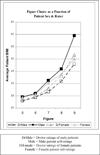Comparison of body perceptions between obese primary care patients and physicians: implications for practice
- PMID: 18583089
- PMCID: PMC3864616
- DOI: 10.1016/j.pec.2008.04.002
Comparison of body perceptions between obese primary care patients and physicians: implications for practice
Abstract
Objective: To compare the body image and weight perceptions of primary care patients and their physicians as a first step toward identifying a potential tool to aid physician-patient communication.
Methods: Patients with a body mass index (BMI)> or =30 (n=456, 66% female) completed body image and weight status measures after office visits; physicians (n=29) rated the body figures and weight status of these same patients after office visits.
Results: Controlling for BMI, female patients and their physicians showed little or no difference in body figure selection or weight status classification, whereas male patients were significantly less likely than their physicians to self-identify with larger body figures (z=3.74, p<0.01) and to classify themselves as obese or very obese (z=4.83, p<0.0001).
Conclusion: Findings reveal that physicians and female patients have generally concordant views of the patient's body size and weight status, whereas male patients perceive themselves to be smaller than do their physicians. The discrepancy between male patient and physician views is especially evident at increasingly larger body figure/weight status categories.
Practice implications: When counseling male patients on weight loss, it could be helpful to assess body image and use this information to raise patient awareness of their size and to facilitate communication about weight.
Figures
Similar articles
-
Weight-related perceptions among patients and physicians: how well do physicians judge patients' motivation to lose weight?J Gen Intern Med. 2006 Oct;21(10):1086-90. doi: 10.1111/j.1525-1497.2006.00567.x. J Gen Intern Med. 2006. PMID: 16970557 Free PMC article.
-
Weight management: what patients want from their primary care physicians.J Fam Pract. 2001 Jun;50(6):513-8. J Fam Pract. 2001. PMID: 11401737
-
Impact of physician BMI on obesity care and beliefs.Obesity (Silver Spring). 2012 May;20(5):999-1005. doi: 10.1038/oby.2011.402. Epub 2012 Jan 19. Obesity (Silver Spring). 2012. PMID: 22262162 Free PMC article.
-
Obese women's perceptions of their physicians' weight management attitudes and practices.Arch Fam Med. 2000 Sep-Oct;9(9):854-60. doi: 10.1001/archfami.9.9.854. Arch Fam Med. 2000. PMID: 11031392
-
Body perception: do parents, their children, and their children's physicians perceive body image differently?J Pediatr Gastroenterol Nutr. 2008 Jul;47(1):76-80. doi: 10.1097/MPG.0b013e31815a34. J Pediatr Gastroenterol Nutr. 2008. PMID: 18607272
Cited by
-
Weight and social comparison: Does the weight of a stranger affect a person's perception of their own weight?Health Psychol Open. 2018 Dec 21;5(2):2055102918819260. doi: 10.1177/2055102918819260. eCollection 2018 Jul-Dec. Health Psychol Open. 2018. PMID: 30622726 Free PMC article.
-
Self-perceived vs actual and desired weight and body mass index in adult ambulatory general internal medicine patients: a cross sectional study.BMC Obes. 2014 Dec 12;1:26. doi: 10.1186/s40608-014-0026-0. eCollection 2014. BMC Obes. 2014. PMID: 26217512 Free PMC article.
-
BMI-based norms for a culturally relevant body image scale among African Americans.Eat Behav. 2013 Dec;14(4):437-40. doi: 10.1016/j.eatbeh.2013.07.005. Epub 2013 Jul 23. Eat Behav. 2013. PMID: 24183131 Free PMC article.
-
Body size perception, knowledge about obesity and factors associated with lifestyle change among patients, health care professionals and public health experts.BMC Fam Pract. 2021 Feb 15;22(1):37. doi: 10.1186/s12875-021-01383-2. BMC Fam Pract. 2021. PMID: 33588766 Free PMC article.
-
An exploration of body dissatisfaction and perceptions of Black and White girls enrolled in an intervention for overweight children.Body Image. 2011 Sep;8(4):379-84. doi: 10.1016/j.bodyim.2011.05.003. Epub 2011 Jun 22. Body Image. 2011. PMID: 21700518 Free PMC article.
References
-
- Flegal KM, Carroll MD, Ogden CL, Johnson CL. Prevalence and trends in obesity among US adults, 1999–2000. J Amer Med Assoc. 2002;288(14):1723–1727. - PubMed
-
- Mokdad AH, Serdula MK, Dietz WH, Bowman BA, Marks JS, Koplan JP. The spread of the obesity epidemic in the United States, 1991–1998. J Amer Med Assoc. 1999;282(16):1519–1522. - PubMed
-
- Allison DB, Fontaine KR, Manson JE, Stevens J, VanItallie TB. Annual deaths attributable to obesity in the United States. J Amer Med Assoc. 1999;282(16):1530–1538. - PubMed
-
- Myers A, Rosen JC. Obesity stigmatization and coping: relation to mental health symptoms, body image, and self-esteem. Int J Obes Relat Metab Disord. 1999;23(3):221–230. - PubMed
-
- National Heart Lung and Blood Institute, National Institute of Health. Clinical guidelines on the identification, evaluation, and treatment of overweight and obesity in adults: The evidence report. Washington DC: Author; 1998.
Publication types
MeSH terms
Grants and funding
LinkOut - more resources
Full Text Sources
Medical


